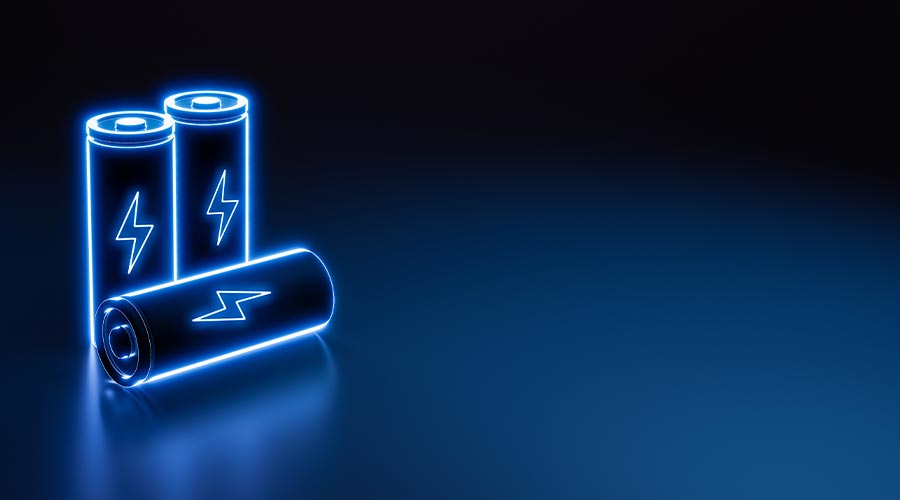
Despite their high cost, lithium-ion batteries are leading the charge in cordless cleaning.
In recent years, lithium-ion batteries have gained popularity in floor care equipment, rapidly replacing lead-acid batteries as the preferred chemistry to power machines big and small — from ride-on sweepers and microscrubbers to backpack vacuums. And it’s no wonder: in addition to being maintenance-free, these batteries have longer run times and faster charging times — attractive features for facilities looking to boost productivity and offset labor costs.
“Now that lithium-ion batteries are becoming available in bigger sizes for bigger machines, they’re a game changer,” notes Glenn Rothstein, retiree and former president of Bio-Shine Inc., Spotswood, New Jersey, which was acquired by Envoy Solutions in 2022 and has since become a BradyPLUS company. “It’s getting to the point where there are lithium batteries for every machine, but it’s only been that way for the last few years.”
Indeed, Dana Kowalski, I.C.E.-GB, vice president of sustainable development, Arnold Sales Complete Janitor Supply, Bay City, Michigan, shares that virtually all the distributor’s battery-powered equipment comes with a lithium-ion battery option. Furthermore, lithium-ion batteries are standard in most of the company’s smaller floor machines.
“One of the big benefits of lithium-ion batteries is that they weigh half as much as lead-acid batteries,” he says. “That’s a big deal when it comes to user comfort and reducing fatigue. We’ve even seen some ride-on equipment where the reduced weight has made a difference in run times.”
One of the biggest deterrents to adopting lithium-ion batteries, however, is their price tag. The cost can be two to three times that of their lead-acid counterparts.
“Every facility cleaning executive should talk to their distributor and do a return on investment,” advises Mickey Crowe, president, CLEEnTech Consulting Group LLC, Woodstock, Georgia. “The machines should pay for themselves in six months to a year through labor savings. That’s the major cost of any custodial contract or operation: labor and benefits. So, that is our motivation.”
Lithium’s Longevity
One of the major benefits of lithium-ion batteries that factor into return on investment (ROI) calculations is their long cycle life compared to lead-acid batteries (a cycle is defined as draining the battery down to a 20 percent state of charge). In general, end users get 3,000-plus cycles out of a lithium-ion battery versus 600-to-750 for a flooded lead-acid battery and 450to-550 for an AGM lead-acid battery.
“Typically, in our market we see lead-acid batteries lasting, on average, two years in automatic scrubbers, whereas lithium-ion batteries will last five years or longer,” notes Kowalski. “Meanwhile, lead-acid batteries have a one-year warranty whereas lithium-ion batteries have a five-year warranty.”
One battery manufacturer claims that lithium-ion batteries run two to three times longer than lead acid batteries before needing to be recharged — a boon for increasing efficiency and ensuring an uninterrupted workflow.
By the same token, charging times for lithium-ion batteries are close to half that of lead-acid batteries, allowing equipment to return to service in a timelier manner. Lead-acid batteries take between eight and 12 hours to reach a full charge, while lithium-ion batteries take between three and five hours to charge, depending on the battery’s capacity and state of charge at the time.
As a rule of thumb, every hour of run time using a flooded lead-acid battery will require two hours of charging, according to Rothstein. And for every hour of run time using an AGM battery, the charge will take four hours. In these situations, charging batteries and equipment overnight is ideal and lead-acid batteries may still be the best option.
In situations where frontline teams need a quick, opportunity charge, lithium-ion batteries are a strong option. Lithium-ion batteries offer the ability to opportunity charge — the practice of charging the battery for short periods when feasible.
“If a person is using an autoscrubber for an hour, they can plug it in and bring it back to full charge without harming the battery. Lead-acid batteries don’t like opportunity charging. It’s harmful to them and reduces their life,” says Kowalski.
Fortunately, smart chargers are now available for all types of batteries to optimize charging, ensuring that users don’t undercharge or overcharge their battery, which could cause equipment to malfunction or overheat.
Additionally, lithium-ion batteries go into sleep mode when left on the shelf for extended periods of time. According to a battery manufacturer, this ensures that the battery does not self-discharge, or it self-discharges such a negligible amount (less than one percent) as to be unnoticeable. In comparison, lead-acid batteries will self-discharge anywhere from five-to-20 percent, depending on the battery’s chemistry.
Switching to Lithium Batteries Can Save on Labor

 The Down and Dirty on Cleaning in Virus Season
The Down and Dirty on Cleaning in Virus Season How Surfactant Use is Expanding in Commercial Cleaning
How Surfactant Use is Expanding in Commercial Cleaning Operational Excellence Series 2025: Labor Strategies
Operational Excellence Series 2025: Labor Strategies
